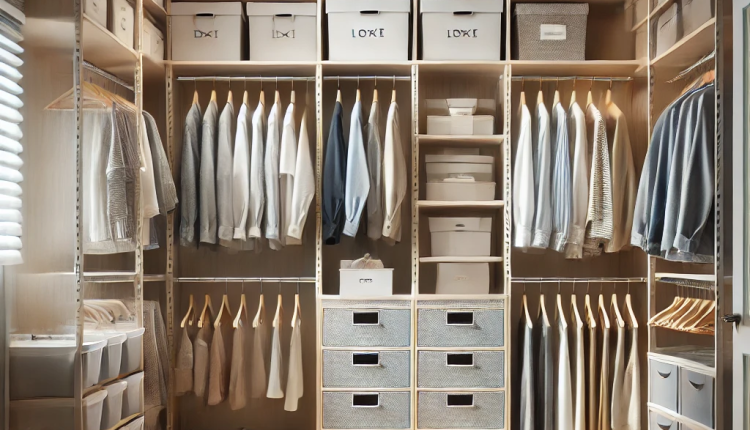How to Maximize Closet Space: A Guide to Efficient Organization
Organizing your closet creates an efficient, tidy space that makes routines simpler. Here’s a full guide on optimizing even small closets, from decluttering to maintaining order over time.
1. Declutter and Prioritize Essentials
Start by taking everything out of your closet. Sort through each item, and keep only what you love or use regularly. Create piles for donating, storing, and tossing items that you don’t need anymore. Decluttering frees up space and lets you make room for items you’ll actually reach for.
This is also a chance to categorize your clothing by season, color, or type, which will help create a foundation for your organization system. For items like formalwear or seasonal clothing, store them out of reach to save space for daily wear.
2. Vertical and Hidden Storage Solutions
Maximize vertical space with additional shelving, hanging hooks, and stackable storage bins. Install upper shelves for storage bins that hold accessories like scarves, belts, or seasonal items. Hanging hooks can be placed along side walls for bags, hats, or even jewelry organizers.
Clear, labeled storage bins make finding accessories simple without needing to rummage through piles. For shoes, use vertical racks or cubbies, keeping frequently used pairs easily accessible.
3. Optimize Hanging Space
Investing in slim, non-slip hangers can add space to your hanging section and keep clothes wrinkle-free. Double hanging rods are ideal for shorter items like shirts, blouses, and pants, maximizing the area. You can even find hanging organizers with compartments that work for folded items like sweaters and jeans, making it easier to keep everything in order.
Consider organizing by category (e.g., workwear, casual clothes, outerwear) or by color to make finding items faster and add visual appeal.
4. Small-Space Organizers for Efficiency
Efficient organizers make a difference in compact spaces. Drawer dividers keep socks, undergarments, and small accessories separate, while a shoe rack on the closet floor or an over-the-door shoe organizer adds functionality. Many over-the-door organizers come with pockets for different items, which can free up shelf or drawer space for larger clothing pieces.
Seasonal items, like thick winter coats or swimwear, can be stored on higher shelves or at the back of the closet, freeing up room for items you need more frequently.
5. Keep Clothes Fresh and Protected
Adding elements like cedar balls, sachets, or moisture absorbers helps keep clothes fresh and protects fabrics from potential moisture or pests. These are particularly useful if you’re storing seasonal items or clothes made of delicate fabrics, like wool or silk.
Consider garment bags for delicate items to avoid dust buildup or wrinkles, especially if they’re not used frequently. For shoes, try placing them in clear boxes or labeled bins to keep dust-free and accessible without taking up extra space.
6. Rotate and Refresh Seasonally
Each season, take time to reorganize. Move seasonal clothing to higher shelves or towards the back, and bring forward the items you’ll need for the current season. Doing this allows you to keep essentials within reach, and minimizes clutter.
Check for any items you didn’t use over the past season, as this may be a sign they’re ready to donate. A seasonal refresh also helps keep everything neat, letting you spot and remove any damaged items.
7. Make the Most of Accessories and Add-Ons
Closet organization doesn’t have to be limited to clothes. Many accessories, like scarves, belts, and jewelry, can be stored with specialty organizers. A jewelry stand or wall-mounted hooks help keep these smaller items organized, easily accessible, and in plain view. Similarly, tie and belt racks are available as door or wall mounts, and keep accessories from tangling.
8. Maintain the System with Regular Check-Ins
Keeping your closet organized long-term requires small efforts every now and then. Once or twice a year, review the organization, assess if certain areas could be adjusted, and check for items that may need mending or replacing. Dedicate even five minutes every week to tidying up any displaced items, and you’ll keep clutter at bay.
Transform Your Closet Into an Efficient Space
An organized closet isn’t just visually appealing; it streamlines your routines and helps you get the most from your wardrobe. With these steps—decluttering, investing in storage solutions, and seasonal refreshing—you’ll enjoy a closet that’s efficient and easy to maintain. The effort you put in now will pay off every time you open the door to a well-arranged space that suits your style and needs.

